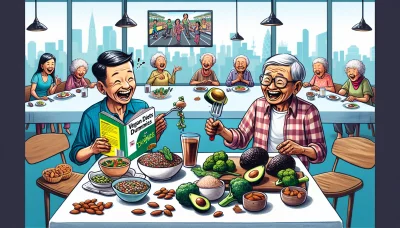High fiber foods and snacks Quiz
Test Your Knowledge
Question of
Understanding High Fiber Foods
Definition and Importance of Dietary Fiber
Dietary fiber is the indigestible part of plant foods that travels through our digestive system, absorbing water along the way and easing bowel movements. It's a crucial component of a healthy diet, often neglected in the modern fast-food era. But let me tell you, its importance is monumental! Not only does fiber help to keep you regular, but it also plays a critical role in maintaining overall gut health.
The benefits of dietary fiber extend way beyond digestion. It's like a superhero for your body, fighting against heart disease, diabetes, and obesity. Plus, it acts as a natural detoxifier, scrubbing away harmful toxins from your gastrointestinal tract. Integrating high-fiber foods into your diet is a game-changer for both your physical health and your energy levels!
Health Benefits of Fiber
Fiber is an all-star nutrient that supports weight management by making you feel full longer. Imagine consuming fewer calories without feeling like you're on a restrictive diet that's fiber working its magic! Moreover, it's been shown to lower cholesterol levels and control blood sugar spikes, providing a buffer against diabetes.
It doesn't stop there; fiber has been linked to reducing the risk of certain cancers like colorectal cancer. By accelerating the elimination of waste from the body, it ensures harmful substances don't linger in the colon. This fantastic nutrient really does pack a punch when it comes to protecting your health!
Daily Recommended Fiber Intake
Are you getting enough fiber? The average adult should aim for about 25 to 30 grams per day from food, not supplements. However, most people fall short of this target. Increasing daily fiber intake can be simple start with integrating more fruits, vegetables, whole grains, and legumes into meals.
To ensure you're meeting your daily goals, plan your meals around high-fiber foods and make them the star of your plate. Remember to increase your intake gradually and drink plenty of water to prevent any digestive discomfort because trust me, you don't want that!
Types of Dietary Fiber
Soluble vs. Insoluble Fiber
Soluble fiber dissolves in water to form a gel-like substance which can help lower glucose levels and blood cholesterol. Found in oats, peas, beans, apples, citrus fruits, carrots, barley and psyllium it's like an internal sponge soaking up those unhealthy substances!
Insoluble fiber does not dissolve in water but adds bulk to the stool helping food pass more quickly through the stomach and intestines. It's found in foods such as whole wheat flour, wheat bran, nuts and many vegetables. Together with soluble fiber, they form an unbeatable duo for maintaining digestive health.
Food Sources for Each Type
- Soluble Fiber: Beans (like navy and kidney), oats/oat bran, nuts (such as almonds), seeds (like chia seeds), some fruits (such as apples and blueberries), and certain vegetables (like Brussels sprouts).
- Insoluble Fiber: Whole grains (like brown rice), wheat bran, corn bran, seeds (such as flaxseeds), nuts (including walnuts) and many vegetables (such as green beans).
Evaluating Fiber Content in Foods
Reading Nutrition Labels
Navigating nutrition labels can be tricky but focus on two things: total carbohydrate and dietary fiber content. Subtracting dietary fiber from total carbs gives you 'net carbs', which is what your body actually digests. Look for foods with high dietary fiber relative to total carbohydrates for the biggest health boost.
High Fiber Foods to Include in Your Diet
- *Legumes: Lentils and black beans are loaded with fiber. *Whole Grains: Choose quinoa or whole grain bread. *Nuts & Seeds: Almonds and flaxseeds are great choices. *Vegetables: Aim for broccoli or artichokes. *Fruits: Raspberries or pears are deliciously high in fiber.
Incorporating Fiber into Your Daily Diet
Planning Balanced Meals with Fiber
Starting your journey towards a high-fiber diet begins with understanding the power of balance. You'll want to ensure that each meal includes a variety of fiber sources such as fruits, vegetables, whole grains, and legumes. This not only provides the necessary fiber but also a range of nutrients to support overall health.
Remember, balance is key! Too much of one type of food can lead to nutritional gaps or even digestive discomfort. Aim for color and variety on your plate to keep meals interesting and nutritious.
Creating a High-Fiber Meal Plan
When crafting your meal plan, focus on incorporating whole foods with naturally occurring fiber. Begin by adding a serving of vegetables to every meal, and choose whole-grain products over refined ones. This will inherently increase your fiber intake without much effort.
Planning ahead is crucial. Spend some time each week mapping out your meals to include high-fiber options. This proactive approach helps prevent last-minute decisions that might lead you away from fiber-rich choices.
Recipes for Fiber-Rich Meals
Dive into the world of high-fiber recipes that are both delicious and nourishing. Use ingredients like quinoa, chia seeds, and berries to create meals that are satisfying and packed with fiber. For instance, a breakfast of overnight oats topped with nuts and fruit can be both a treat and a fiber boost.
Cooking at home allows you to control the ingredients and pack in the fiber. Simple swaps like using beans as a protein source in tacos or adding lentils to your soup can significantly increase the fiber content of your favorite dishes.
Snacking on High Fiber Options
Snacks are an excellent opportunity to sneak more fiber into your diet. Opt for raw veggies with hummus or fresh fruit rather than processed snacks. These choices provide a quick fiber boost and help keep hunger at bay between meals.
The right snacks can also help manage weight by keeping you full longer, thanks to the satiating power of fiber. Be mindful of portion sizes though; while high-fiber snacks are beneficial, calories still count!
Healthy High-Fiber Snacks
- Pear slices with almond butter offer a sweet crunch with a dose of healthy fats.
- Air-popped popcorn is a whole grain that provides volume and fiber with few calories.
- Mixed nuts and dried fruits make for an energy-packed snack that's rich in fiber.
- Veggie sticks paired with guacamole combine the goodness of avocado with the crunch of fresh vegetables.
- Rice cakes topped with avocado are not only trendy but also a quick way to get both healthy fats and fiber.
Preparing Easy Fiber-Rich Snacks at Home
Making high-fiber snacks at home doesn't have to be complicated or time-consuming. With some planning, you can prepare batches of snacks like roasted chickpeas or homemade granola bars over the weekend for easy grab-and-go options during the week.
D.I.Y. snack-making lets you avoid added sugars and preservatives found in many store-bought products. Plus, it's often more cost-effective, so your wallet will thank you too!
Overcoming Common Dietary Challenges
Incorporating more fiber into your diet can come with its challenges, particularly if you're dealing with food sensitivities or new digestive reactions as your body adjusts. It's important to increase fiber gradually and drink plenty of water to aid digestion.
If you experience discomfort, consider tracking your food intake to identify potential triggers. Sometimes specific types of fiber may be easier for you to handle than others.
Managing Fiber Intake with Food Sensitivities
Navigating food sensitivities requires attention to detail when increasing dietary fiber. For those sensitive to gluten, for instance, choosing gluten-free whole grains like brown rice or quinoa can provide needed fiber without adverse effects.
Fruits like bananas and oranges are often well-tolerated by those who have trouble digesting fructans found in other fruits. Everyone's body is differentlisten to yours!
Adjusting to Increased Fiber Consumption
A gradual increase in dietary fiber allows your digestive system time to adapt without discomfort. Start slowadd just one new high-fiber food at a time while monitoring how your body reacts.
Honor your body's signals; if certain high-fiber foods don't agree with you even after gradual introduction, it's okay! There is an abundance of different types of fibers found across various foodsexperiment until you find what works best for you.
High Fiber Diets for Weight Management
Role of Fiber in Weight Loss
Fiber is a weight loss superhero! It's not digested by your body, so it moves through your system, making you feel full without adding extra calories. It's like having a secret weapon in your battle against the bulge. Foods rich in fiber often require more chewing, giving your body time to register when you're no longer hungry, so you're less likely to overeat. Incredible, isn't it?
But wait, there's more! Fiber helps regulate blood sugar levels, which can prevent those pesky hunger pangs that lead to unhealthy snacking. It's like having a steady hand guiding your appetite, keeping those cravings at bay. Plus, a high-fiber diet is often rich in nutrients and low in calories and fat, making it a win-win for weight loss warriors!
How Fiber Aids in Feeling Full
Fiber has this amazing ability to soak up water as it moves through your digestive system, expanding like a sponge. This expansion fills you up and keeps you satisfied for hours! Imagine eating a meal and feeling content all the way until your next one that's fiber working its magic.
What's more, certain types of fiber can ferment in the colon, producing short-chain fatty acids that also promote fullness. It's like fiber is throwing a fullness party in your stomach, and everyone's invited. So go ahead and RSVP 'yes' to high-fiber foods they're the guests of honor at the table of satiety!
Impact of Fiber on Metabolism
Fiber isn't just about feeling full; it also has a profound effect on metabolism. High-fiber foods work harder during digestion, burning more calories in the process talk about an internal workout! Plus, they keep your gut bacteria happy and healthy, which plays an essential role in how effectively you metabolize food.
Let's not forget that fiber can help sweep away some of that unwanted cholesterol from your bloodstream. This means your heart doesn't have to work as hard, indirectly boosting your metabolism by improving overall health. Its like giving your body an internal tune-up with every high-fiber meal!
Designing a Weight Loss Plan with High Fiber Foods
When designing a weight loss plan centered around high-fiber foods, start by setting goals that make sense for you. Aim for gradual weight loss rather than immediate drastic changes think marathon, not sprint! Incorporating fiber into every meal is like laying bricks for the foundation of a healthier lifestyle.
Now lets talk specifics: fruits like raspberries and pears are packed with fiber; veggies such as broccoli and Brussels sprouts are bursting at the seams too; whole grains like barley and bran are stellar choices; legumes? Lentils and black beans are where its at! Nuts and seeds? Flaxseeds and almonds have got you covered. Remember to drink plenty of water these foods love to absorb it!
- Eat varied sources of fiber: Mix fruits, vegetables, legumes, nuts, seeds, and whole grains.
- Increase fiber intake gradually: Give your digestive system time to adjust.
- Stay hydrated: Drink plenty of water to help fiber do its job properly.
- Avoid processed foods: They're often low in fiber and high in calories.
- Read food labels: Choose products with higher fiber content.
- Mindful eating: Chew slowly; it aids digestion and satisfaction levels.
Success Stories and Case Studies
The proof is out there! Many people have transformed their lives by switching to high-fiber diets. Take Sarah: she lost 30 pounds just by making fiber her friend no gimmicks or fads needed! These stories aren't anomalies; they're testaments to the power of paying attention to what you eat.
The science backs it up too! Studies show individuals consuming high-fiber diets tend to be leaner and less likely to gain weight over time. Researchers are constantly amazed by the clear link between dietary fiber intake and weight management its undeniable evidence that this stuff works wonders!
High Fiber Foods for Digestive Health
Improving Digestive Function with Fiber
Fiber is a powerhouse when it comes to enhancing our digestive function. It's not just about avoiding that sluggish feeling; it's a crucial component of a well-oiled digestive system. By introducing more high-fiber foods into your diet, you can kick your digestion into high gear, leading to smoother processing of the foods you love.
The magic of fiber doesn't stop there! It's like a personal trainer for your intestines, bulking up the food you eat and making sure everything moves along as it should. This bulking action is key to preventing those pesky digestive issues that can throw off your day.
Fiber's Role in Digestive Health
Imagine fiber as the unsung hero maintaining peace in the realm of your gut. It works tirelessly, sweeping through the digestive tract, grabbing onto waste and toxins, and ensuring they're escorted out of your body efficiently. This process not only keeps you feeling light but also reduces the risk of complications down the road.
When you're getting enough fiber, your body will let you know with clear signs. You'll notice regular bowel movements, less bloating, and a happier gut overall. These are tell-tale signs that fiber is doing its job, keeping your digestive health on track.
Signs of Improved Digestion with High Fiber Intake
One of the most noticeable signs that high fiber intake is working wonders for your digestion is regularity. No more waiting around or feeling uncomfortable; your body becomes a clockwork machine! And let's not forget about the reduction in bloating say goodbye to unbuttoning your pants after meals.
Another fantastic benefit? A smooth digestion process often leads to increased energy levels. Why? Because when your system isn't bogged down with processing heavy foods, it can focus on fueling you for the day ahead!
Managing Digestive Disorders with Diet
- Eat: Incorporate soluble fibers such as oat bran, barley, nuts, seeds, beans, lentils, and peas.
- Avoid: Limit or eliminate high-fat foods and certain high-fiber foods like raw fruits and vegetables during flare-ups.
- Moderation: Introduce insoluble fibers gradually to avoid gas and bloating.
- Hydration: Drink plenty of water to help fiber do its job effectively.
- Consultation: Always consult with a healthcare provider before making significant dietary changes.
For those dealing with IBS or diverticulitis, diet management can be a game-changer. By emphasizing certain high-fiber foods while avoiding triggers, individuals can experience significant relief from their symptoms. It's all about finding that sweet spota balance that keeps both you and your gut happy.
When constipation enters the chat, fiber is often the first topic brought up by healthcare professionals. That's because increasing dietary fiber is one of the most effective ways to get things moving again. It softens stool and increases its bulk, which prompts your bowels to move no harsh chemicals required!
Role of Fiber in Preventing Constipation
If constipation has got you feeling down, look no further than fiber to lift you back up! It's renowned for its ability to prevent this common digestive issue by adding bulk to stool and speeding up its journey through the intestines.
Think of fiber as nature's broom it sweeps through your colon cleaning out waste and reducing the time it lingers there. This not only helps prevent constipation but also decreases the likelihood of developing more serious conditions like colorectal cancer.
Probiotics and Fiber: The Perfect Pair
Combining probiotics with high-fiber foods is like forming an all-star team for gut health. Probiotics introduce beneficial bacteria into the gut ecosystem while fiber provides them with nourishment to thrive on.
- Fermented Foods: Include yogurt, kefir, sauerkraut, kimchi, and kombucha in your diet.
- Diverse Fiber Sources: Eat a variety of high-fiber foods like fruits, vegetables, legumes, whole grains.
- Synergy: Understand that probiotics and prebiotics work best together one supports gut flora while the other feeds them.
The dynamic duo works hand-in-hand creating an environment where good bacteria can flourish. This symbiotic relationship lays down the foundation for a robust digestive system capable of tackling whatever comes its way.
Special Diets and Fiber Considerations
Exploring the world of nutrition reveals the undeniable importance of fiber, irrespective of dietary preferences. Special diets often require extra attention to ensure adequate fiber intake, which is crucial for digestive health, weight management, and chronic disease prevention. Embracing a diet that aligns with personal health needs while maintaining optimal fiber levels can be a thrilling journey towards wellness!
Whether you're gluten-free, low-carb, or plant-based, fiber should remain a starring component of your meals. Let's delve into how various diets can be optimized for fiber intake without sacrificing dietary restrictions or preferences. It's time to get excited about the endless possibilities for nutritious and delicious high-fiber eating!
High Fiber Options for Gluten-Free Eating
Identifying Gluten-Free, High-Fiber Foods
Finding high-fiber foods that are also gluten-free can seem like a daunting task but it doesn't have to be! Whole foods such as fruits, vegetables, beans, and seeds are naturally gluten-free and packed with fiber. These nutrient powerhouses not only support a healthy gut but also contribute to the overall richness of a gluten-free diet.
Quinoa, chia seeds, and flaxseeds are just a few examples of versatile ingredients that can boost your fiber intake while keeping gluten at bay. Discovering these gems opens up a world of culinary creativity and health benefits!
Adapting Recipes for Gluten Sensitivity and High Fiber Needs
Adapting recipes for those with gluten sensitivity doesn't mean compromising on fiber. In fact, it's an opportunity to get innovative in the kitchen! By substituting traditional grains with high-fiber, gluten-free alternatives like brown rice flour or almond meal, you maintain the structure of your favorite dishes while enhancing their nutritional profile.
Incorporating legumes such as lentils or chickpeas into recipes not only adds texture and flavor but also significantly ups the fiber content. The key is to experiment with substitutions until you find the perfect blend that satisfies both your palate and dietary requirements.
Low-Carb Diets and Maintaining Adequate Fiber Intake
Finding the Balance: Low-Carb and High-Fiber Foods
Navigating a low-carb diet while ensuring sufficient fiber intake might seem contradictory at first glance but it's absolutely achievable! Focus on foods that are both low in net carbohydrates and high in dietary fiber such as avocados, nuts, and certain berries. These foods allow you to enjoy the benefits of a low-carb lifestyle without neglecting your body's need for fiber.
- Aim for non-starchy vegetables like broccoli or spinach which provide volume and nutrients without too many carbs.
- Include seeds such as chia or flaxseeds; they're not just low-carb but also rich in omega-3 fatty acids.
- Select berries over other fruits; they tend to be lower in carbs while still providing antioxidants alongside their fiber content.
- Don't forget nuts; almonds and pecans are particularly low in carbs yet offer a satisfying crunch along with their fibrous benefits.
- Consider psyllium husk as an addition to meals or shakes; it's almost pure dietary fiber.
Keto-Friendly High-Fiber Options
The ketogenic diet emphasizes fat over carbs but integrating high-fiber foods is essential for digestive health. Thankfully, many keto-friendly options pack a substantial fiber punch. Leafy greens like kale and swiss chard can become staples in your keto repertoire due to their minimal impact on carb counts yet significant contribution to your daily fiber goals.
Nuts and seeds play an important role here too they not only add texture to meals but also provide essential vitamins and minerals alongside their fibrous content. By strategically selecting these types of foods, adhering to keto guidelines becomes not only manageable but also beneficial for long-term health.
Vegan and Vegetarian Diets: Maximizing Fiber Benefits
Plant-Based Sources of High Fiber
Vegan and vegetarian diets are inherently rich in high-fiber foods which makes meeting daily requirements somewhat less challenging. Legumes such as beans, lentils, and peas are stars in this category offering robust flavors along with hefty doses of both protein and fiber.
Diversity is key; incorporating a wide range of vegetables ensures not only colorful plates but also an array of fibers that benefit different aspects of gut health. Whole grains are another cornerstone think quinoa, barley, and whole wheat providing sustainable energy while keeping you full longer due to their high-fiber content.
Meeting Nutritional Needs with a High-Fiber Plant-Based Diet
A plant-based diet brimming with high-fiber foods supports more than just digestion; it also plays a role in heart health and blood sugar regulation. To optimize these benefits, focus on variety each plant-based food brings its own set of nutrients alongside its fibrous content.
Balancing fruits with vegetables ensures an intake of both soluble and insoluble fibers which work together for maximum health benefits. Don't overlook nuts and seeds either; they're not just tasty snacks but vital components that contribute essential fats along with their dietary fibers. Embrace the plant-based abundance for both its deliciousness and its contribution to your well-being!
Kid-Friendly High Fiber Foods and Snacks
Making Fiber Fun for Kids
Fiber is a superstar nutrient for children, playing a crucial role in digestion and overall health. Yet, many kids fall short on fiber intake. Making fiber fun can turn this around! By incorporating it into foods they love, we can ensure our kids get the fiber they need without the fuss.
Getting creative with presentation can make a world of difference. Use cookie cutters to shape high-fiber whole grain bread or create colorful fruit kabobs that are as fun to make as they are to eat. The key is to associate fiber-rich foods with enjoyment rather than obligation.
Creative Ways to Introduce More Fiber into Your Child's Diet
Boosting your child's fiber intake doesn't have to be a battle. Start by swapping out refined grains for their whole-grain counterparts. Think whole wheat pasta, brown rice, and quinoa which can be easily introduced into familiar meals. Even small changes like these can significantly increase your child's daily fiber consumption.
Another great tactic is involving kids in meal prep. When children help make their snackslike assembling a trail mix with nuts, seeds, and dried fruitsthey're more likely to enjoy eating them. It's an engaging way to educate them about healthy choices!
Kid-Approved High-Fiber Recipes
Let's talk deliciousness! Whip up a batch of oatmeal banana pancakes or blend a berry and spinach smoothie for a fiber-rich breakfast treat. These recipes are not only packed with essential nutrients but also pass the taste test with flying colors.
For dessert or snack time, consider homemade granola bars or apple slices with almond butter. These tasty treats keep the fiber high and the sugar low, perfect for keeping energy levels steady throughout the day.
School Lunches with a Fiber Boost
Lunchtime at school is an opportunity to reinforce healthy eating habits. A lunchbox filled with high-fiber foods keeps kids full longer and supports concentration for afternoon classes. The goal is to pack lunches so appealing that they won't be tempted to trade them away!
Think outside the traditional lunchbox fare by introducing diverse textures and flavors. A wrap with hummus, shredded carrots, and lettuce offers a satisfying crunch while ticking off several high-fiber boxes.
Packing a High-Fiber Lunchbox
- *Include fresh fruits like pears or apples; their skin contains extra fiber. *Opt for whole grain breads or wraps instead of white bread. *Add veggies like bell peppers or cucumbers as crunchy sides. *Choose legumes such as chickpeas or kidney beans in salads or as hummus. *Incorporate nuts and seeds in trail mixes or as toppings. *Select high-fiber snacks like popcorn over chips. *Use avocado as a spread; it's creamy and full of fiber.
Teaching Kids to Choose High-Fiber Options at School
Educating children about healthy choices empowers them to make better decisions when faced with various options at school. Discussing the benefits of fiber and identifying fiber-rich foods can lead them to consciously choose the salad bar over less nutritious alternatives.
Involving kids in packing their own lunches also fosters independence while ensuring they understand what goes into their bodies. It's important they recognize why choosing whole grains over processed snacks will benefit them in more ways than one.
Dealing with Picky Eaters
Picky eaters pose unique challenges when trying to increase dietary fiber intake. However, patience and persistence often pay off. Starting slow by introducing new foods alongside favorites can gradually expand their palates without overwhelming them.
Making mealtime stress-free is essential for picky eaters who may associate trying new foods with pressure or anxiety. Maintain a positive atmosphere where new tastes are celebrated rather than forced.
Tips for Encouraging Variety in a Picky Eater's Diet
- *Be patient: Introduce new foods slowly alongside familiar favorites. *Stay positive: Keep mealtimes upbeat and avoid pressuring your child. *Be creative: Disguise fibers in smoothies or use cookie cutters on whole-grain bread. *Involve your child: Let them help prepare meals which increases interest in eating them. *Lead by example: Eat a variety of high-fiber foods yourself; kids learn by watching you! *Offer choices: Giving limited options between two high-fiber snacks gives them control. *Praise successes: Celebrate when they try something new, even if its just one bite. *Keep it regular: Consistency helps normalize the presence of new, high-fiber foods.
Sneaking Fiber into Favorite Kids' Meals
Incorporating fiber into meals that your child already loves is an effective tactic. Blend beans into spaghetti sauce or add pureed vegetables into casseroles for an unnoticeable fiber boost that doesn't compromise taste.
Baking can also be an excellent opportunity to sneak in extra fibersubstitute part of the flour in recipes with whole wheat flour or oat bran. These subtle changes can enrich favorite treats with beneficial nutrients without altering flavor too much.
Tracking and Improving Your Fiber Intake
Tools for Monitoring Dietary Fiber
Keeping an eye on your fiber intake has never been easier, thanks to technology. There are numerous apps available that not only track your daily food consumption but also break down the nutrients, including fiber. This is a game-changer in managing a balanced diet!
Understanding portion sizes is crucial when it comes to tracking fiber. A handy kitchen scale or measuring cups can help you get this right. Once you know how much fiber is in each portion, you'll be better equipped to meet your daily goals.
Setting and Achieving Fiber Goals
Setting realistic daily fiber targets is key to dietary success. The recommended intake varies by age and sex, but generally, adults should aim for 25-30 grams per day. Start by knowing these numbers and then tailor your goals accordingly!
To avoid discomfort, it's essential to increase your fiber intake gradually. This approach allows your digestive system to adapt without causing adverse effects like bloating or gas. Remember, patience is vital in this journey towards a healthier gut!
Learning from Dietary Feedback
Your body knows best! Pay close attention to how it responds to different levels of dietary fiber. Some might experience increased energy and improved digestion, while others may need to adjust their intake if discomfort arises.
Dietary feedback can come in many forms from digestive changes to overall well-being. Use this feedback to fine-tune your diet. Perhaps adding more water or adjusting fiber types could make all the difference in optimizing your health.
- Maintain a Food Diary: Keep track of what you eat and the corresponding fiber content.
- Use Technology: Leverage apps that specifically track nutrients including fiber.
- Read Labels: Get into the habit of reading nutritional information on food packaging.
- Educate Yourself: Learn about high-fiber foods and how you can incorporate them into your meals.
- Listen to Your Body: Note any physical changes or discomfort as you adjust your fiber intake.
- Increase Gradually: Avoid gastrointestinal issues by slowly upping your fiber consumption over weeks.
- Balanced Approach: Combine soluble and insoluble fibers for optimal benefits.
- Stay Hydrated: With increased fiber, water is essential to help move things along in your system.
- Variety is Key: Don't just stick to one source of fiber; diversify your diet with fruits, vegetables, legumes, grains, and nuts.
- Routine Check-ins: Regularly assess if your current intake aligns with your health goals and make adjustments as needed.












